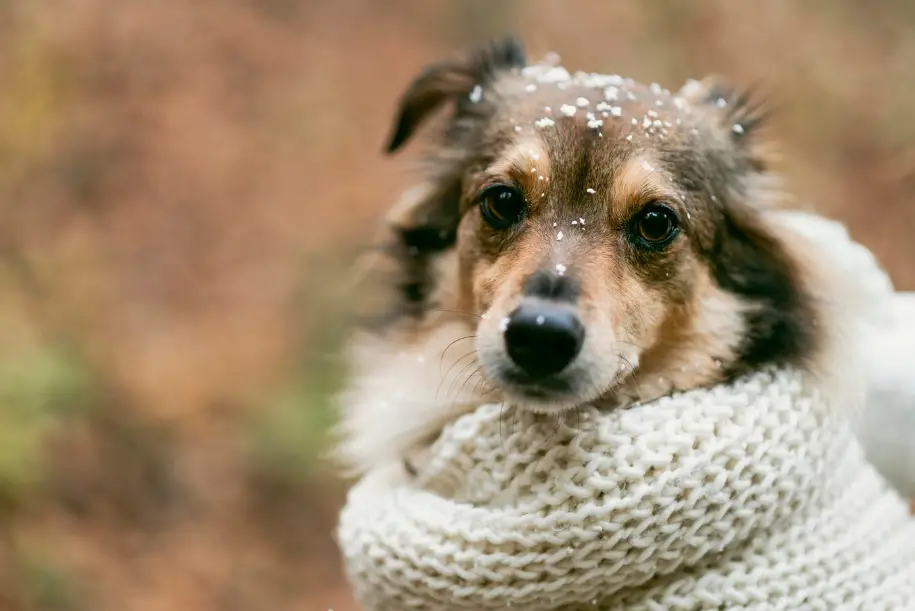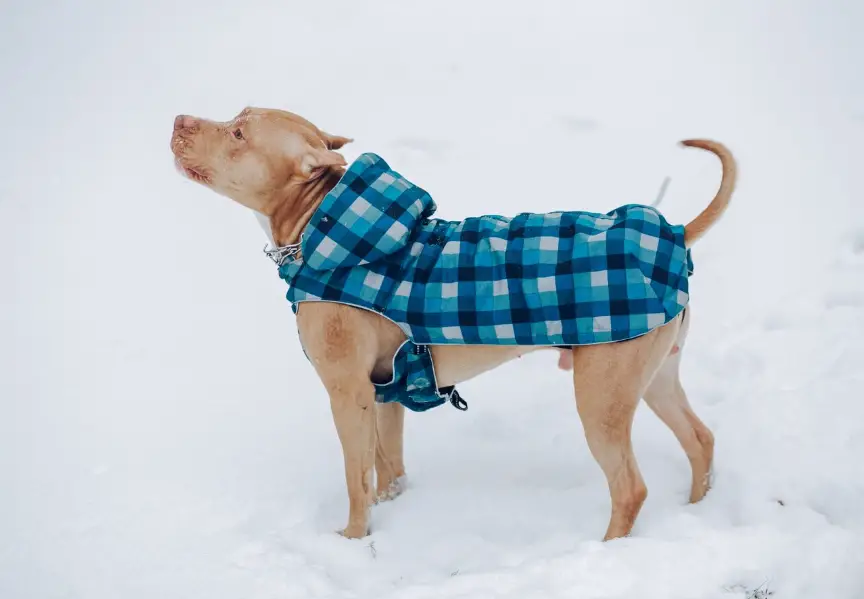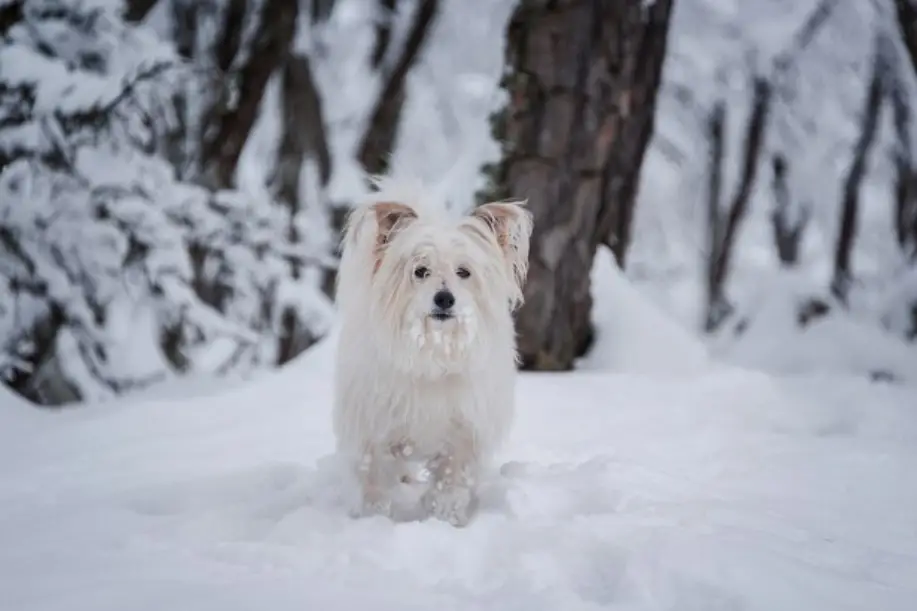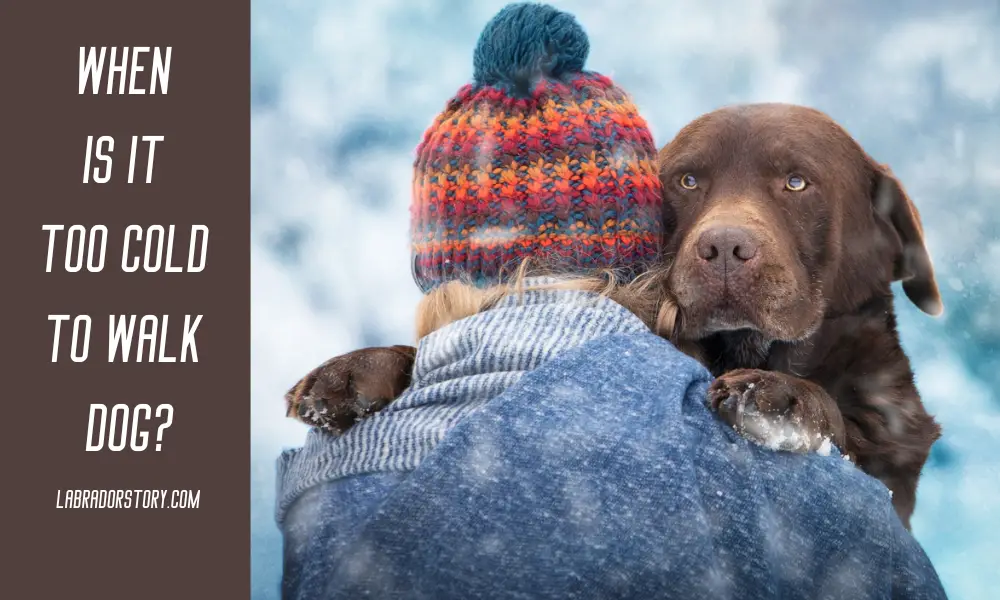Last Updated on November 17, 2023 by Linda Richard
Large dogs or small dogs, they all need outdoor exercise. It is wonderful when in the warm season it brings pleasure to both your pet and you. But what about the weather in winter, when the temperature is low and there is already a question, not only in the need to walk the dog, but also that it would be safe for him. In this article I will tell you as much as possible at what temperature you can walk your dog and how to protect him from the cold weather.
Table of Contents
At What Temperature Should I Walk My Dog?
Small dogs with no undercoat and short-haired breeds are vulnerable to the cold, while large dogs can tolerate colder temperatures.
Comfortable clothing conditions for miniature breeds and short-haired dogs come when the thermometer rises above 20 degrees – 23 degrees ℉. Keep this in mind when taking your furry friend for a walk, and avoid walking when the temperature drops below 5 ℉, even if he’s wearing a jacket.
Dog breeds with thick, long coats and undercoats can tolerate extreme cold down to – 45 degrees, but only if their bodies are ready for it. Animals accustomed to the warmth of an apartment are not recommended for long walks at temperatures of -4 ℉ and below.
With puppies and older animals, it’s best to be more careful, as they may be more vulnerable to the cold. If you are unsure about something, it is better to leave the animal at home or take it out for a short walk.


How Long Should You Walk Your Dog in Cold Weather?
Staying out in the cold for too long can be just as dangerous for most dogs as it is for humans. Just because they are covered in fur doesn’t mean they aren’t susceptible to illnesses and injuries that become common with the arrival of cold weather. Being out in the cold for too long can cause harm, so it’s important to limit the amount of time your pet spends outside during especially cold weather. This doesn’t mean that your dog shouldn’t walk in cold weather or when there is snow for longer than they need to fulfill their physiological needs. In fact, watching a dog frolic in the snow is one of the greatest joys for its owner. Playing in the snowballs that the dog will catch can be the exercise he needs to lose the weight he gained during the winter. But if you’re starting to get cold outside, your pet may be getting chilly, too.
At temperatures above 23 ℉ medium and large dogs can walk for about half an hour, while smaller dogs can walk for about 20 minutes. However, keep in mind that due to other factors, it may be colder outside than it actually is. For example, a strong wind can turn a relatively mild day into a freezing cold day. A walk in the snow can also be nice on a beautiful sunny day, but if you’re walking through wet snow and slush, your dog’s body temperature can drop pretty quickly, even when he’s moving. Don’t let your pet eat snow, as this can also lower their body temperature.
Even if you have an outdoor playpen or kennel for your dog in your yard, remember to take him inside after short periods of being outside. Never leave your dog outside overnight. If she is used to spending most of her time outside, you can set up a warm place for her in the garage. If your pet spends some time in his kennel, put blankets or towels there for him to wrap himself in and change them every day as they get cold. It may not be unreasonable to splurge on heat lamps to keep the booth at a normal temperature.
There’s nothing wrong with your dog being outside in cold weather, but you should bring him inside after he’s been outside for a long time to avoid health problems.

How Can You Tell if Your Dog is Freezing Outside?
Pets react to the cold the same way we do, but they can’t tell us about discomfort. You need to be able to recognize the signs that indicate your dog is freezing outside. Signs your dog is cold:
- Shivering, hunched posture with tail tucked. The dog shakes with its tail pressed against its belly. Shivering and wanting to curl up is a natural reaction of the body, an attempt to keep warm.
- Cold ears or body. If your dog’s ears are freezing outside, especially around the edges, it’s time to take him indoors and cover him with a blanket.
- Slow movements. Your four-legged friend is showing that she doesn’t like being outside. The dog walks slowly, tries to hide behind bushes, objects or under them from the cold, snow, wind or rain.
- Restlessness, reluctance to continue walking, attempts to climb into your arms or return home.
- Dog treads cautiously or limps, raises and holds paw above ground. Dog’s paws can also freeze when the dog is cold to walk.
- Whining, barking. If your dog is cold outside and uncomfortable, he may try to let you know about it.

What to do For Hypothermia in Dogs?
If your dog is suffering from mild hypothermia, there are a number of steps you should take to bring him out of it:
Take your dog to a warm and dry room. If possible, increase the temperature of the room. Dry it with a towel. For a better effect, you can place the towel on a hot radiator beforehand. However, do not overheat the pet. It will be helpful to warm the dog with your own body. If possible, cuddle the dog and cover him with your own clothes. This will make him feel safe and his body temperature will return to normal. Give the dog warm, but not hot, water.
If the animal’s body temperatures drops to 33-35 degrees, you should not risk the animal’s life, it is better to take it to a doctor immediately.

Prevention of Hypothermia in Dogs
Here are some tips for keeping pets safe during the winter recommended by veterinarians:
- the best way to prevent hypothermia and colds is not to leave your pet out in the cold for long periods of time and to monitor their well-being in freezing or inclement weather;
- if you notice your dog is cold outside, warm him up and bring him home;
- protect cold-sensitive pets with water resistant coat (overalls, coats) or sweaters, especially small dogs, as they are more sensitive to cold weather and low temperatures;
- take frequent breaks indoors during walks to allow your dog to warm up and dry off;
- if your dog has a long coat, snow can accumulate in it quickly and should be shaken off. Your dog can get hypothermia if there is a wind chill outside and the dog’s coat is wet from snow;
- do not allow your dog to eat snow;
- keep an eye on the weather forecast, don’t take your dog for a walk if you are cold in warm clothes;
protect your pet’s paws from frost, road salt and reagents, ice melting chemicals by buying him shoes or treating them with special means.
If the animal has to stay outdoors for long periods of time or is a guard dog, it should be provided with a heated enclosure, an insulated box with a wooden floor, a heated drinker and calorie-rich food.

Read also: Labrador Retriever Temperature Tolerance And How To Keep Your Dog Safe
Which Dogs Freeze Outside the Most Often?
Sensitivity to cold depends on the breed (fur density, body build), age, health and housing conditions of the pet. A healthy and well-groomed coat protects against the cold by trapping body heat near the skin. If the coat is wet or tangled, it loses its insulating protection.
Small dogs get cold faster than large dogs. Breeds with short coats (and no undercoat) do not fare well in the cold. The fur of outdoor pets becomes much thicker in winter. It is important to keep a close eye on the condition of the coat and care for it.
Sick, emaciated, thin dogs, puppies or old pets, dogs with low blood sugar levels (hypoglycemia), impaired thermoregulation, hypothyroidism or those who have undergone anesthesia and surgery are prone to rapid hypothermia.
Dog breds to live in colder climates – Alaskan Malamutes, Siberian Huskies, Samoyeds and other northern varieties – tend to have fewer cold weather problems. Breeds that are not adapted to living in the cold can suffer, even if they have thick coats.
Conclusion
Wind chill, cold temperatures, walking for too long, these are factors that your dog shouldn’t walk outside for too long to avoid damaging his health. In extreme cold, try to leave your pet at home, or only take them out for their natural needs.
Sometimes it’s enough to look at a dog to realize: it’s made for cold weather. Siberian Huskies, Malamutes and St. Bernards greet snow and winter weather with joyful barking. They’re covered in thick, warm fur that serves as their natural insulation. But dogs of some other breeds start to shiver at the mere thought of having to go outside when a blizzard begins.
Some animals don’t just feel uncomfortable in winter – winter can even be dangerous for them. That’s why you should still take some precautions when walking your dogs when the temperature drops.
When walking your dog, you should remember that even in cold weather it is necessary to protect the paws, for this purpose there are special shoes or products for treating the dog’s paws.
Watch This Video:
FOTO:


Image source: freepik.com
Image source: freepik.com


FAQs
How cold is too cold for dogs UK?
A: The UK has a wide range of temperatures, and the answer to this question will depend on what type of dog you have. For example, if you have a small breed like a Maltese or Yorkie, they can handle colder weather than larger dogs like an English Bulldog or German Shepherd.
How do you know when a dog is cold?
A: Dogs can be cold or warm. When a dog is cold, its nose will be wet and the pads of their feet will be dry. This is because when dogs are cold, they pant to cool down their blood vessels in order to reduce heat loss.
How cold is too cold for Labradoodles?
A: Labradoodles are a breed of dog that is considered to be a medium-sized, non-sporting dog. They are typically bred for their intelligence and ability to adapt to various environments. As such, they can survive in temperatures as low as -40 degrees Fahrenheit.
The “what temperature is too cold for puppies” is a question that many people ask. There’s no one answer to this question, but the general consensus of when it’s too cold for a Labrador Retriever is around 10 degrees Fahrenheit.


3 thoughts on “When Is It Too Cold To Walk Dog? How To Protect Your Dog From The Cold”
Comments are closed.